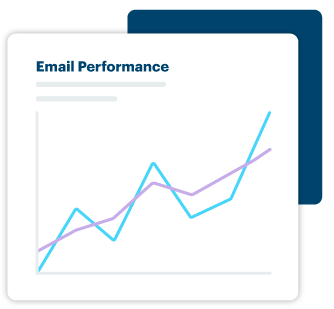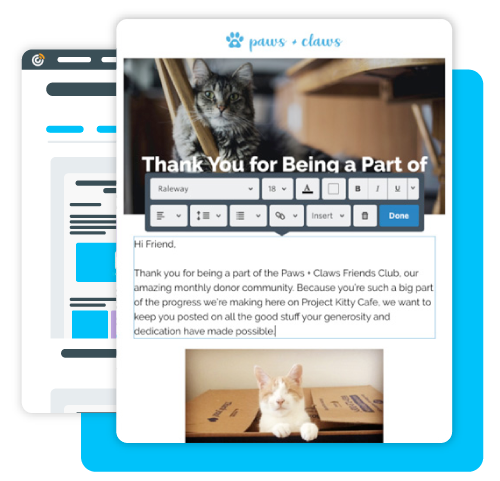Nonprofit Technology & Fundraising Blog
Subscribe to our mailing list

November 2, 2023 | GivingTuesday, Online Fundraising, Year End
The average person receives more emails in a day than they can realistically read, much less respond to or act on. The average donor also cares about more causes than they can realistically support at one time.
These factors can make it difficult for nonprofits to send Giving Tuesday emails that stand out in their supporters’ inboxes, and even more difficult for those emails to result in a donation – but we’re here to help. The DonorPerfect team partners with Constant Contact, the nonprofit industry’s premier email marketing platform, to provide you with tried-and-true, data-driven best practices.
Below, we’ve broken your Giving Tuesday emails into six components:
Use the following tips to make the most of your available space on Giving Tuesday.
What factors contribute to a favorable open rate? Research shows that almost half of recipients (47%) open their emails based on the subject line alone, and that 6-10 words is usually the sweet spot for length.
As far as character count goes, mobile inboxes commonly cut off subject lines at about 30 characters, and web-based inboxes at about 60 characters. Within these constraints, your nonprofit must communicate a need and convince your supporters of their ability to help.
For emails sent to your donor prospects (and any supporters who might be new to your Giving Tuesday program or cause), it only takes a few words to provide a very concise description of your Giving Tuesday efforts:
If your campaign name adequately describes your reason for fundraising, you can include it in your subject line to save characters and build recognition, ex. “Join our Reducing Recidivism program.”
Pro tip: If ever you are torn between two subject lines, try an A/B test! This tactic helps you learn your audience and leverage their preferences in order to be more successful in future email solicitations. Just take your email list and split it down the middle – send Subject A to one half, and send Subject B to the other. See which one performs best.

With limited characters to use, details about your Giving Tuesday goal might not make it into your subject line. Not to worry, because your email’s preheader – the text that appears next to or underneath the subject line in an inbox – can give you some extra space. Following best practices for nonprofit email marketing, you can use about 80-100 characters to explain your Giving Tuesday Goal in the preheader.
Pro tip: Nonprofit email tools like Constant Contact allow you to write your own preheader text and preview how it will look in your donors’ inboxes, so you can determine how well it supports your subject line. These tools are included in every DonorPerfect package, so your organization can take advantage of Constant Contact no matter your size or scope!

Be sure to put the most important information at the beginning, and include an amount, quantity, and/or timeframe to make it tangible, ex. “Help us raise $1k in 1 day! These 5 families deserve a Merry Christmas.”
Donors are more likely to support a campaign with a goal that is close to being met, so the more attainable you can make it feel, the better. Try this method as an attention-grabber in the preheader text, ex. “Just $2 from you would help us to reach our goal.”
According to cognitive scientist Jerome Bruner, delivering your message in a story format makes it 22 times more memorable. Telling a story behind your Giving Tuesday campaign can make all the difference in how new donors feel about their first giving experience with your organization and what keeps them around for their second and third.
Tap into your emotions about why you got involved with your organization in the first place. Think of recent conversations with beneficiaries, board members, and volunteers. Ask your colleagues what projects or programs come to mind when thinking about your Giving Tuesday campaign, or your mission in general. Together, brainstorm what might motivate some of your most dedicated donors.
These days, just about any email your donors receive will have their first name included in the subject line or the body, so that information alone is likely not enough to make your message feel personal.
To send emails that stand out in your donors’ inboxes, be sure to include personalized data about their giving history, like their last gift amount, the date of their last gift, or their lifetime contribution to your nonprofit.
Knowing that you cared enough to keep track of their gifts and specifically mention them in your communications makes them feel appreciated, thus more connected to your nonprofit and its mission – especially your smaller, more inactive donors, as they account for 80% of all donors giving at year-end.
Pro tip: Dynamic content (or “dynamic fields”) allow you to automatically load donor and gift information from your database into the desired fields in your prepared email template – no manual entry needed. If using Constant Contact, your dynamic fields will be synced with your database, so you can update information without having to enter it twice.

To ensure your Giving Tuesday message maintains its relevance, try grouping your donors together by giving history – create email recipient lists for donors who gave last year but not this year, donors who usually give at this time of year, etc. Slightly tweak your messaging so that it is tailored to each group, and using dynamic fields, add details about their most recent gift. (Pressed for time? An AI content generator can help!)
Ask them if they’d like to give the same amount or increase their contribution this year. Explain how their gift supported your work and clarify what an increase would do. A subject line as simple as “Can we count on you again this year?” or “An update on your $[##] gift” shows them that you took the time to send an email that’s relevant to their giving interests, and that their past contributions meant a lot to you.
For Giving Tuesday solicitations, it makes the most sense to start with your existing donor base and divide it into segments based on giving history (as explained in “Personalization”). In addition to past Giving Tuesday donors, consider reaching out to your recurring donors, long-time donors, volunteers, and board members.
Why? A few reasons:
They know you, so they are less likely to ignore/miss your email, even if it comes too early for them to start thinking about their Giving Tuesday contribution. And more time could mean more funds (which us leads to reason #2).
You can rally your current supporters by asking them to talk to friends and family, or set up their own crowdfunding page to fundraise on your behalf. By the time your donor prospects receive an appeal closer to Giving Tuesday, they may have already heard of you through word of mouth!
They’ve given to your campaigns before, and you’ve shown them that they are a valued participant. Have them interact with your online fundraising tools and ask for feedback. If your campaign needs an adjustment, you have time to make it before potentially scaring off new prospects during crunch time.
Your CTA should always lead readers exactly where they intend to go.
If your email CTA directs donors to “Give now,” make sure that the button or link takes them directly to your online donation page, without any stops along the way. Otherwise, they could become frustrated and give up on their donation altogether, or feel that they were taken to an untrustworthy page, which could have an adverse affect on your relationship.
Need more help with Giving Tuesday or year-end appeals? Download your free Year-End Bundle below, which includes the Giving Tuesday Cheat Sheet, End of Year Cheat Sheet, and AI for Nonprofits: Enhance Your Fundraising Communications.
Follow us on social!